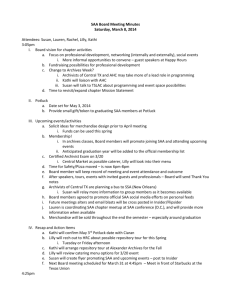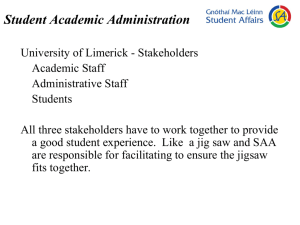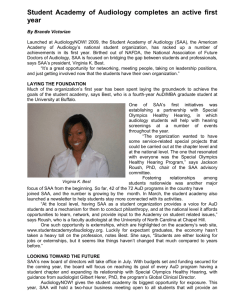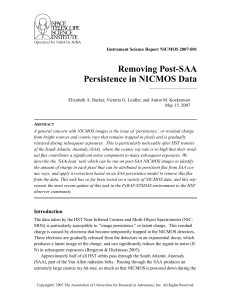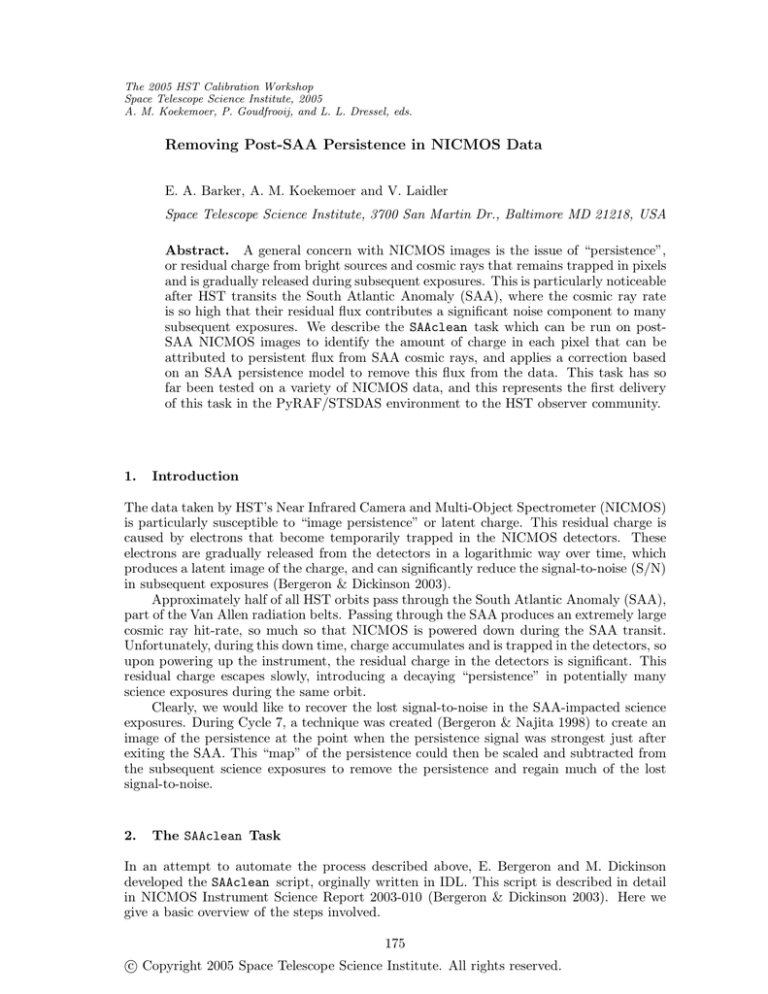
The 2005 HST Calibration Workshop
Space Telescope Science Institute, 2005
A. M. Koekemoer, P. Goudfrooij, and L. L. Dressel, eds.
Removing Post-SAA Persistence in NICMOS Data
E. A. Barker, A. M. Koekemoer and V. Laidler
Space Telescope Science Institute, 3700 San Martin Dr., Baltimore MD 21218, USA
Abstract. A general concern with NICMOS images is the issue of “persistence”,
or residual charge from bright sources and cosmic rays that remains trapped in pixels
and is gradually released during subsequent exposures. This is particularly noticeable
after HST transits the South Atlantic Anomaly (SAA), where the cosmic ray rate
is so high that their residual flux contributes a significant noise component to many
subsequent exposures. We describe the SAAclean task which can be run on postSAA NICMOS images to identify the amount of charge in each pixel that can be
attributed to persistent flux from SAA cosmic rays, and applies a correction based
on an SAA persistence model to remove this flux from the data. This task has so
far been tested on a variety of NICMOS data, and this represents the first delivery
of this task in the PyRAF/STSDAS environment to the HST observer community.
1.
Introduction
The data taken by HST’s Near Infrared Camera and Multi-Object Spectrometer (NICMOS)
is particularly susceptible to “image persistence” or latent charge. This residual charge is
caused by electrons that become temporarily trapped in the NICMOS detectors. These
electrons are gradually released from the detectors in a logarithmic way over time, which
produces a latent image of the charge, and can significantly reduce the signal-to-noise (S/N)
in subsequent exposures (Bergeron & Dickinson 2003).
Approximately half of all HST orbits pass through the South Atlantic Anomaly (SAA),
part of the Van Allen radiation belts. Passing through the SAA produces an extremely large
cosmic ray hit-rate, so much so that NICMOS is powered down during the SAA transit.
Unfortunately, during this down time, charge accumulates and is trapped in the detectors, so
upon powering up the instrument, the residual charge in the detectors is significant. This
residual charge escapes slowly, introducing a decaying “persistence” in potentially many
science exposures during the same orbit.
Clearly, we would like to recover the lost signal-to-noise in the SAA-impacted science
exposures. During Cycle 7, a technique was created (Bergeron & Najita 1998) to create an
image of the persistence at the point when the persistence signal was strongest just after
exiting the SAA. This “map” of the persistence could then be scaled and subtracted from
the subsequent science exposures to remove the persistence and regain much of the lost
signal-to-noise.
2.
The SAAclean Task
In an attempt to automate the process described above, E. Bergeron and M. Dickinson
developed the SAAclean script, orginally written in IDL. This script is described in detail
in NICMOS Instrument Science Report 2003-010 (Bergeron & Dickinson 2003). Here we
give a basic overview of the steps involved.
175
c Copyright 2005 Space Telescope Science Institute. All rights reserved.
176
Barker, Koekemoer and Laidler
Figure 1: One SAA dark image, scaled to show cosmic rays (left) and the persistence image
generated by the SAAclean task to clean the SAA-induced cosmic rays (right).
The SAAclean script will run through the procedure below if the time elapsed between
the science image and the last SAA exit is less than 5600 sec (94 minutes, or 1 orbit)
(Bergeron & Dickinson 2003). If the time elapsed is greater than this, the script exits
without processing the science image. We presume that science images taken this long after
the SAA exit are not affected by the SAA passage. If the time elapsed since the last SAA
exit is less than 5600 sec, then the script proceeds as described below. If, after the script
has run, the resultant correction to the science image is determined to be less than 1%, the
script does not apply the correction and the science image remains unchanged.
It is recommended, but optional, to correct the input science image for the pedestal
effect using the pedsky or pedsub IRAF tasks before processing with the saaclean script.
We believe performing the pedestal correction will improve the detection of the persistence
due to the SAA passage. If a science image has been impacted by the SAA passage, the
SAA DARK header keyword will be populated with the name of the association table that
points to the two post-SAA dark images correlated with the science image. Using the two
post-SAA dark images, a decay scale factor is determined, and then the two images are
averaged together with some cosmic ray rejection. The result is then pedestal corrected,
which provides an image of the persistence (see Figure 1).
This image of the persistence is then iteratively scaled by the scale factor between the
two post-SAA dark images, fitting to the scale factor that provides the minimum total noise
in the final output image, and then subtracted from the input science image. If desired, an
additional and optional pedestal removal can be done at this point. We expect the results of
this pedestal correction to be better than the first pedestal correction, since the persistence
has now been removed from the science image.
Bergeron’s original IDL script has been converted to a PyRAF task in Python code
by V. Laidler at STScI. As with any such conversion between languages, some algorthmic
changes are occasionally necessary. These algorthimic changes are kept to an absolute
minimum and used only when the original code does not have a precise equavalent in the
new language.
The SAAclean task produces several intermediate and final statistics as output data,
indicating the values it calculates in determining a possible correction value to be applied to
the science data (see the example output in Figure 2). This output includes the SAAclean
input filename, persistence scale factor, threshold for determining the high S/N pixel regime
Removing Post-SAA Persistence in NICMOS Data
177
saaclean version 0.5 (15 Sep 2005)
Input file: n90j55z2q_ped.fits
Using scale factor of 0.54 to construct persistence image
Bad pixel image filename obtained from /data/cdbs5/nref//m991700on_flt.fits
median used in flatfielding: 0.0304204884365
Threshold for hi/lo: 0.0698112137616
Npixels hi/lo: 8000 57536
Results summary for high domain:
chi2 for parabola fit = 0.00074004532324
min-noise (best) scale factor is: 0.250980787999
effective noise at this factor (electrons at gain 5.400000): 41.598116
noise reduction (percent)
: 15.945775261
Results summary for low domain:
chi2 for parabola fit = 2.1850359789e-05
min-noise (best) scale factor is: 0.216667701363
effective noise at this factor (electrons at gain 5.400000): 32.178225
noise reduction (percent)
: 2.4951591989
Applying noise reduction in both domains
Figure 2: An example of SAAclean output.
versus the low S/N pixel regime, the number of pixels in each regime, and best fit factors
and noise values for each regime.
As noted in the original SAAclean ISR (Bergeron & Dickinson 2003), any correction
determined by the SAAclean task is applied to the input science exposure (see Figure 3).
We assume here that the given recommendation of pedestal correcting the science exposure
before running SAAclean has been done. If so, this implies that the SAAclean correction
is applied to the pedestal corrected science image.
3.
Testing of the SAAclean Task
We have tested the SAAclean task on the vast majority of existing NICMOS data, utilizing
all three cameras (NIC1, NIC2, NIC3). In order for SAAclean to run, several header
keywords must be populated in the input science exposure header. The FLATFILE keyword
must be populated with the name of the corresponding flat field image filename. The
SAA DARK keyword must be populated with the name of the association table containing
the names of SAA dark images associated with the science exposure. These keywords are
typically populated automatically by the OTFR processing when the data is requested from
the archive.
We are currently making slight modifications to the SAAclean task in an aim to improve functionality over a broad range of data types and to make it slightly more user
friendly. We have found that enabling the use of lists of filenames (@-files) can make the
task more more efficient to use. We have also modified the original script behavior of using
an input parameter to determine the gain of the science image. We are now extracting the
gain given in the science image header. In addition, the task uses the bad pixel file specified
in the image header to flag pixels that should not be used to determine the SAA correction.
Finally, the Pyraf task differs from the IDL version in that, while it still calculates the
SAA image using a pedestal-corrected image, the resulting correction is applied directly
to the calibrated NICMOS exposure (which has not necessarily been run through pedsky).
This provides users with more control over the processing steps, since it is often desirable
to run additional pedestal correction after having applied the SAA correction.
178
Barker, Koekemoer and Laidler
Figure 3: An SAA-impacted, input pedestal-corrected image (left) and the output SAAclean
image (right), which has fewer low-level residual cosmic rays.
4.
Summary
NICMOS images are strongly impacted by SAA passages through latent charge remaining
in the detectors, which causes “persistence” in subsequent exposures. We have tested a new
PyRAF task, based on the SAAclean script developed by Bergeron and Dickinson, which
can remove much of the SAA-induced persistence and regain otherwise lost signal-to-noise.
After testing the new SAAclean task on essentially all existing NICMOS archived data,
we see that in most cases, SAAclean generally improves the signal-to-noise of objects of
interest, unless there are problems with the data unrelated to the SAA passage.
5.
Future Work
We are currently in the process of modifying the task to be incorporated into the standard
calibration pipeline for NICMOS data. The pipeline task would be performed after calnica
and before calnicb. We do not expect to change the underlying SAAclean algorithm, but
various keyword functions and properties are being handled such that they are pipelinestandard compliant. We expect the pipeline version of the SAAclean task to be available
to the community by late spring or early summer of 2006.
References
Bergeron, L. E. & Dickinson, M. E. 2003, Instrument Science Report NICMOS 2003-010
(Baltimore: STScI), available through http://www.stsci.edu/hst/nicmos
Bergeron, L. E. & Najita, J. R. 1998, BAAS, 30, 1299



